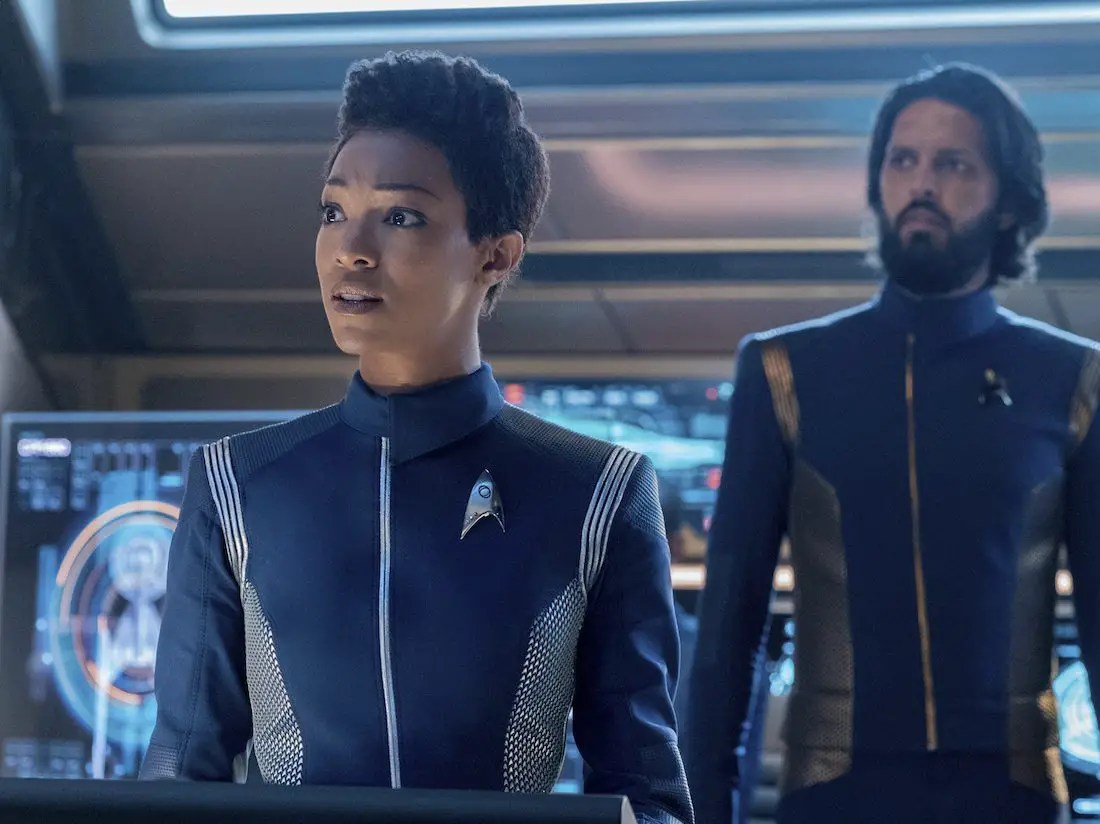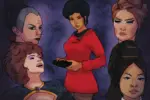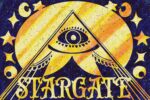The “Star Trek” prime timeline has a set canon, and many are wondering — some even at odds — with how “Discovery” fits into the already established sequence of events. With obvious issues like the spore drive and Michael Burnham being Spock’s younger sister, the writers for “Discovery” decided to “fix” these issues by throwing the crew 900 years into the future. This decision has improved the show, but why did it receive so much negative feedback in the first place?
The Moving Parts of “Star Trek” Canon
For those new to the “Star Trek” fanbase, Fandom.com hosts the Memory Alpha database, which is a great resource for learning background information about characters and other parts of the universe. This of course includes a chart of when each spin-off series takes place within the prime timeline.
In order to discuss “Discovery,” the process by which canon is assessed and determined needs to be addressed. According to the Memory Alpha canon page, there are two major parts to consider: canon and fanon. Essentially, the term “canon” refers to any television show or feature film.
“Fanon,” however, comes from “fan canon,” and it refers to “certain ‘facts’ that may have been accepted as truth by a large number of fans, and thus either replaces an established canonical fact in the minds of those fans, becoming retroactive continuity or fills a plot-hole.” Many “Star Trek” fans see this as a hierarchy of canon, especially when the lit-verse is involved. There are enough fans to consider the books and comics “fanon,” but they will never have more authority than the official television shows or feature films.
This being the case, the “Star Trek” franchise is majorly responsible for “fandoms” as they exist today; as a result, the amount of content created in the “fanon” is nothing short of breathtaking. In addition to the multiple spin-off shows, there is a lit-verse that fans and even actors on the show have worked hard to put together. Using content from both television and film, over 2000 books and comics have been created in order to extensively develop the worlds. While “fanon” will never have more authority than “canon,” there is a great deal of value placed on story continuity. Those who are new to the fandom might not recognize that continuity errors not only affect the new television show, but they also go against a long history of worldbuilding that creators — of canon and fanon — have spent years of their lives developing.
What are the Issues?
“Star Trek: Discovery” had a rough start largely due to its low number of episodes per season. Past “Star Trek” shows worked with anywhere from 20 to 30 episodes per season, yet the longest season of “Discovery” only had 15. The slower-moving plots of the older series allow for the ship to accomplish its main goal: to seek out and explore new life. Many of the episodes that leave out the main plot are spent developing individual characters, creating the community bond onboard the ship, and discovering new cultures. “Discovery” did not have the time to do this. With any reboot series, the writers need to figure out how to appease the longtime fans and also make the show appealing to a new audience — which is never an easy task.
This added restriction made pleasing both audiences close to impossible. “Discovery” turned into a condensed version of “Star Trek,” revolving around the central character, Michael Burnham. The pacing and style of the first season mimicked the J. J. Abrams films, which take place in what is referred to as the “Kelvin” timeline (also canon). The Klingons are designed similarly to those in the Abrams films; there is plenty of action and mutiny, and climbing the ranks through unofficial channels is commonplace. There was just one problem: “Discovery” was supposed to be set in the prime timeline, with all the other “Star Trek” television shows. There was no mention of the Kelvin universe until Season 3.
The majority of fans’ negative feedback circles around “Discovery” routinely disregarding already established worldbuilding in favor of special effects, intense fight scenes and any possible opportunity to glorify Michael Burnham. If this had been set in the Kelvin timeline, there would be no issue. Setting it in the prime timeline creates three major problems: the Klingons’ design, Burnham’s familial ties and Discovery’s spore drive.
The Klingon design is an obvious error, but it is one that can be overlooked as it does not break the canon in a detrimental way; while there are some references to the Klingon change in costume between “Original Series” and “Next Generation,” the plot in the second series was not majorly affected. Similarly, “Discovery” remained relatively unaffected by the costume change.
And while this irritated some fans, more people started to get angry when the show revealed that Spock is Michael Burnham’s older brother. This is an issue because Spock has never mentioned having a human sister, despite speaking about his family on many occasions.
The biggest plot hole is the ship itself. Discovery’s spore drive, which allows instantaneous travel between two points without the use of warp travel, would have changed how many of the future events played out. Previous “Star Trek” iterations have discussed at great lengths the connection between technology and a culture’s advancement. “Discovery” not only leaves out the discussion of the cultural impact surrounding this ship design, but it also fails to recognize how this might create major plot holes in series that take place in the future, especially in “Star Trek: Voyager.”
How Has “Discovery” Tried to Fix These Issues?
Considering this negative feedback, the writers decided to make two major changes. First, they introduced a partner series, titled “Star Trek: Short Treks,” where they took the same cast and filled in more of the content and background gaps. Second, the writers elected to push the crew nine centuries into the future, giving themselves a clean slate to work with.
Ryan Britt explained in his article published through SYFYWIRE how removing Discovery “fixed” the canon, as far as Season 2 is concerned.
“As Spock said, removing Discovery from the galaxy in the 23rd century fixed not only a plot problem but a canon issue, too. But Spock wasn’t done fixing canon in the finale! And that’s because the episode goes one step further. Spock straight-up tells Starfleet command that everyone who knows about Discovery and ‘her Spore Drive’ should be forbidden ‘under penalty of treason’ from ever talking about the ship or its crew, ever again. With this one line, Spock is basically turning to the camera and saying to the crankier fans, ‘Hey, this is why I never talked about my human sister before, okay? You haters all happy now?’”
Though the change of setting prevents further damage, the audience is left with a simple promise that Spock and Starfleet will never speak of this again. Given how uneasy fans were about these plot holes, more explanation may be needed to completely fix the present issues. Hopefully, the new show — “Star Trek: Strange New Worlds” — will explain this cover-up in more detail.
Season 3 stayed away from the earlier timeline for the most part, which redirected audience attention away from the continuity errors. There were several references to the Kelvin timeline as well, likely setting up elements for future seasons. This connection is likely to make the show more accessible to the new fanbase, and bridge the gap between the two timelines.
Above All, “Star Trek” is About Optimism and Exploration
Aside from some general stylistic and pacing issues, there are some major additions that were nice to see. “Star Trek” has always valued representing minority groups, from Lieutenant Uhura showing the first interracial kiss on television to Jadzia Dax showing the fifth lesbian kiss on TV. Many “Star Trek” fans have been asking for LGBT representation for a long time, and in Season 3, “Discovery” included a gay couple in the main cast with a nonbinary child.
“Discovery” also goes more in detail with other characters’ backstories, uses story points from old episodes and showcases the philosophical debate that is missing from the first two seasons. Captain Saru, in an effort to save an extremely isolated Kelpien, explores his own past in order to help another save the future; Saru illustrates the dangers of never engaging with the outside world and how it can stunt emotional development and prevent one from ever moving on from past trauma. This showcases the importance of connecting with one another, a topic that is relevant to today’s culture.
Even though there are major plot holes that still need to be fixed, “Discovery” has regained the heart of what “The Original Series” and all other “Star Trek” series aimed to do: provide an optimistic message that will last.

















